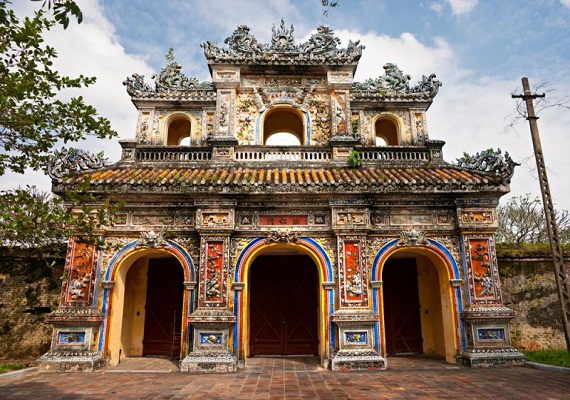Complex of Hué Monuments
Established as the capital of unified Viet Nam in 1802, Hué was not only the political but also the cultural and religious centre under the Nguyen dynasty until 1945. The Perfume River winds its way through the Capital City, the Imperial City, the Forbidden Purple City and the Inner City, giving this unique feudal capital a setting of great natural beauty.

Outstanding Universal Value
Brief synthesis
The Complex of Hue Monuments is located in and around Hue City in Thua Thien-Hue Province in the geographical centre of Vietnam and with easy access to the sea. Established as the capital of unified Vietnam in 1802 CE, Hue was not only the political but also the cultural and religious centre under the Nguyen Dynasty, the last royal dynasty of Vietnamese history, from 1802 to 1945 CE.
The plan of the new capital is in accordance with ancient oriental philosophy, and respected the physical conditions of the site.
The Ngu Binh Mountain (known as the Royal Screen) and the Perfume River, which runs through the city, give this unique feudal capital an entire setting of great natural beauty as well defining its symbolic importance. The site was chosen for a combination of natural features – hills representing a protective screen in front of the monuments or taking the role of “a blue dragon” to the left and “a white tiger” to the right – which shield the main entrance and prevent the entry of malevolent spirits. Within this landscape, the main features of the city are laid out.
The structures of the Complex of Hue Monuments are carefully placed within the natural setting of the site and aligned cosmologically with the Five Cardinal Points (centre, west, east, north, south), the Five Elements (earth, metal, wood, water, fire), and the Five Colours (yellow, white, blue, black, red).
The central structure is the Hue Citadel area which was the administrative centre of southern Viet Nam during the 17th and 18th centuries CE. Within the Hue Citadel were located not only administrative and military functions of the Empire, but also the Imperial Residence, the Hoang Thanh (Imperial City), the Tu Cam Thanh (Forbidden Purple City) and related royal palaces.
Tran Binh Dai, an additional defensive work in the north-east corner of the Capital City, was designed to control movement on the river. Another fortress, Tran Hai Thanh, was constructed a little later to protect the capital against assault from the sea.
Outside the Capital City there are several associated monuments of importance. In the outlying areas were located important ritual sites related to the spiritual life of the dynasty such as the Van Mieu (Temple of Literature), the Dan Nam Giao (Esplanade of Sacrifice to the Heaven and Earth), the Ho Quyen (Royal Area), the Den Voi Re (Temple of the Roaring Elephant), and the Chua Thien Mu (Celestial Lady Pagoda). Further upstream, arranged along the Perfume River were the tombs of the dynasty’s emperors.
The Complex of Hue Monuments is a remarkable example of the planning and construction of a complete defended capital city in a relatively short period in the early years of the 19th century CE. The integrity of the town layout and building design make it an exceptional specimen of late feudal urban planning in East Asia.

Criterion (iv): The Complex of Hue Monuments is an outstanding example of an eastern feudal capital.

